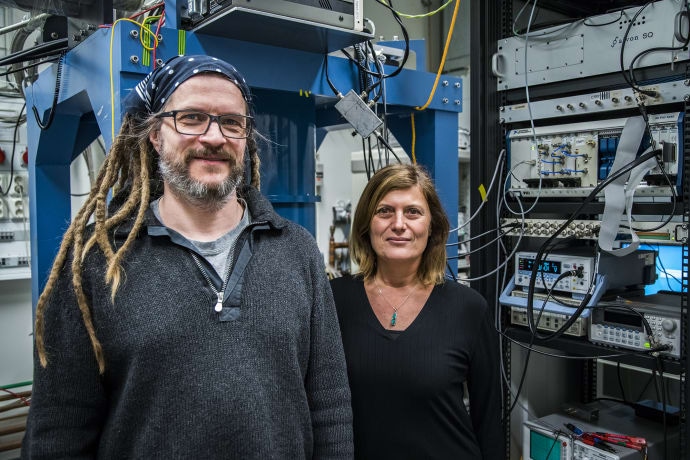Feb 20 2018
With their insensitivity to decoherence what are termed as Majorana particles could become stable building blocks of a quantum computer. The issue is that they only occur under highly special circumstances. Currently, researchers at Chalmers University of Technology have been successful in manufacturing a component that can host the sought-after particles.
 After an intensive period of analyses the research team was able to establish that they had probably succeeded in creating a topological superconductor, exciting new technology for quantum computing. (Image credit: Johan Bodell/Chalmers)
After an intensive period of analyses the research team was able to establish that they had probably succeeded in creating a topological superconductor, exciting new technology for quantum computing. (Image credit: Johan Bodell/Chalmers)
Researchers across the world are struggling to design a quantum computer. One of the big challenges is to surpass the sensitivity of quantum systems to decoherence, collapse of superpositions. One track within quantum computer research is thus to make use of what are called Majorana particles, which are also referred to as Majorana fermions. Microsoft is also aiming to develop this type of quantum computer.
Majorana fermions are extremely original particles, relatively unlike those that constitute the materials around us. In very simplified terms, they can be viewed as half electron. In a quantum computer, the idea is to encode information in a pair of Majorana fermions which are detached in the material, which should, in principle, make the calculations resistant to decoherence.
So where can one find Majorana fermions?
In solid state materials, they only seem to occur in what are termed as topological superconductors – a new type of superconductor that is so new and exceptional that it is barely ever found in practice. But a Chalmers research team is presently among the first in the world to submit results signifying that they have truly succeeded in manufacturing a topological superconductor.
“Our experimental results are consistent with topological superconductivity,” says Floriana Lombardi, Professor at the Quantum Device Physics Laboratory at Chalmers.
To build their unconventional superconductor, they began with what is known as a topological insulator made of bismuth telluride, Bi2Te3. A topological insulator is mostly just an insulator – in other words, it does not conduct current – but it conducts current in a very special manner on the surface. The researchers have positioned a layer of a conventional superconductor on top, in this case, aluminum, which conducts current totally without resistance at very low temperatures.
“The superconducting pair of electrons then leak into the topological insulator which also becomes superconducting,” explains Thilo Bauch, Associate Professor in Quantum Device Physics.
However, the preliminary measurements all showed that they only had standard superconductivity induced in the Bi2Te3 topological insulator. But when they cooled the component down again later, to consistently repeat some measurements, the situation unexpectedly changed – the characteristics of the superconducting pairs of electrons were diverse in different directions.
“And that isn’t compatible at all with conventional superconductivity. Suddenly unexpected and exciting things occurred,” says Lombardi.
In contrast to other research teams, Lombardi’s team used platinum to put together the topological insulator with the aluminum. Repeated cooling cycles brought on stresses in the material, which caused the superconductivity to alter its properties.
After an intensive period of analyses, the research team was able to determine that they had perhaps succeeded in developing a topological superconductor.
“For practical applications the material is mainly of interest to those attempting to build a topological quantum computer. We ourselves want to explore the new physics that lies hidden in topological superconductors – this is a new chapter in physics,” Lombardi says.
The results were just published in the scientific journal Nature Communications in a paper titled “Induced unconventional superconductivity on the surface states of Bi2Te3 topological insulator”.